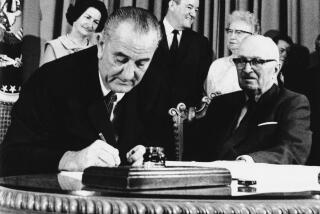Soviets Hint OK of ‘Star Wars’ Tests : Signal They May Accept Development Outside Laboratories, Senators Say
- Share via
WASHINGTON — The Soviet Union has sent a signal to U.S. arms negotiators in Geneva that Moscow may be willing to negotiate an arms agreement that would permit some testing of the “Star Wars” space-based missile defense system, congressional leaders said Thursday.
Members of a congressional delegation that observed the U.S.-Soviet arms negotiations in Geneva last weekend said that the Soviets have indicated a willingness to discuss testing of the Strategic Defense Initiative outside the laboratory--something that the Kremlin has adamantly rejected in the past.
The possibility of a breakthrough on an SDI provision coincides with a current offer by the Soviets to eliminate intermediate-range nuclear missiles in Europe and to allow each side only 100 such warheads elsewhere. SDI testing is a separate issue because it falls under a different category of arms control negotiations.
The new development also comes at a time when the Administration and congressional Democrats are engaged in a domestic battle over whether the 1972 Anti-Ballistic Missile Treaty should be reinterpreted to allow “Star Wars” testing.
‘Big Opening There’
Some Administration officials have expressed skepticism that the Soviets are serious about discussing the SDI issue, but the congressional observers hailed it as a positive sign in U.S.-Soviet arms talks. “I think there’s a big opening there,” said Sen. Arlen Specter (R-Pa.), a member of the congressional observer group in Geneva.
And Senate Majority Leader Robert C. Byrd (D-W.Va.) called on the President to respond affirmatively to the offer, even though some liberal Senate Democrats oppose SDI development.
“This flexibility should be aggressively pushed by our negotiators, and I would hope that the White House will provide the necessary instructions to those capable negotiators to explore these vital matters,” Byrd said in a floor speech earlier this week.
Sen. Richard G. Lugar (R-Ind.), also a member of the observer group, said that the apparent opportunity for a breakthrough in U.S.-Soviet arms talks on SDI testing as well as intermediate-range missiles should persuade Democrats not to challenge the Administration’s view of the ABM treaty.
The President needs a “bipartisan window of opportunity” by Congress to negotiate a comprehensive arms control agreement, Lugar said.
As evidence of the Soviets’ willingness to discuss SDI testing, these senators noted that Soviet leader Mikhail S. Gorbachev said earlier this week that “the conclusion” of an agreement governing space weaponry “should be conditioned by a decision on the prevention of deployment of weapons in outer space.”
Deliberate Omission?
In the statement, Gorbachev omitted saying “development,” which he usually does in referring to deployment--an omission that is viewed by some experts as deliberate.
In addition, Specter and Lugar said, the U.S. observers were told directly by the Soviet arms negotiators last weekend that the omission was intended as a signal that Gorbachev is willing to discuss the matter. The Soviets told the senators that he was prepared to send the same signal during his summit meeting with Reagan last October in Iceland but that the President never raised the question specifically.
U.S. and Soviet negotiators long have been at odds on the limits imposed by the ABM treaty, and the Soviets’ objection to deployment and testing of weapons in outer space has stymied U.S.-Soviet talks on the issue.
The treaty, which was ratified by the Senate and remains in effect, forbids national anti-missile networks, allowing only 100 ABM weapons on each side and restricting any further conventional defenses to research. However, the treaty does not contain specific provisions that apply to technology developed on the basis of “other physical principles,” saying only that such systems would be “subject to discussion.”
Since 1985, the Soviets have maintained that only SDI research within a laboratory is permitted, while the Administration has broadened its initial view. Although it now insists that “research, development and testing” is permitted, the Administration has said that it will adhere to the narrower interpretation, at least for now.
‘Several Miles Long’
Lugar and Specter said they were told by the Soviet negotiators that a laboratory for testing space weapons could be defined as “several miles long, several miles high”--a much broader definition than the Soviets have used in the past.
Although Ambassador Max M. Kampelman, the chief U.S. arms negotiator, said he viewed it as “a significant change” in the Soviet position, Kenneth L. Adelman, head of the U.S. Arms Control and Disarmament Agency, insisted in an interview Thursday that “there is no significance in the move.”
A middle view came from Jack Mendelsohn, deputy director of the Arms Control Assn., a private group that champions arms control, who said there is “not much substantive change, but the change represents progress.”
Mendelsohn pointed out that, during the treaty’s 1972 ratification proceedings, the chief U.S. negotiator and his chief scientist told the Senate that “everything short of testing an ABM weapon prototype was permitted.”
In a related development, Defense Secretary Caspar W. Weinberger said in a speech on Thursday that the United States could deploy a layered, space-based defense system against nuclear missiles as early as 1993. It was his most optimistic forecast yet on prospects for SDI deployment.
“We are not in a position to make a deployment decision yet and will not be for the next year or two,” he said. “However, I believe there is great promise that a robust, layered, space-based strategic defense system could be deployed as early as 1993 or 1994 if a decision is made to do so.”
More to Read
Sign up for Essential California
The most important California stories and recommendations in your inbox every morning.
You may occasionally receive promotional content from the Los Angeles Times.











